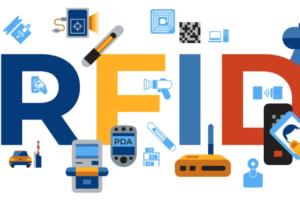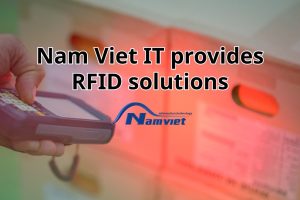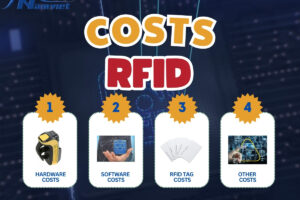Nowadays, RFID radio frequency identification technology has become a powerful tool in monitoring, managing and operating businesses. However, whether to choose active or passive RFID cards is still a question that needs to be answered by experts. The article comparing active RFID and passive RFID tags by IT Nam Viet will help you find the most accurate answer.

Overview of Active RFID Tags
Active RFID tags are tags that have their own power supply, and they continuously transmit signals to RFID readers. Simply put, active RFID tags are tags that are equipped with their own internal battery and transmitter in the form of a beacon or responder. This means that active tags can continuously transmit signals to RFID readers up to 150 meters away, depending on the frequency level.
Active RFID tags are often used to determine the exact real-time location of tagged objects, especially RFID applications in non-stop toll collection. Active RFID tags have a longer reading range than passive tags, but of course, the cost will also be higher than passive tags.

Accordingly, the two main frequencies used for active RFID systems are 433 MHz and 2.45 GHz. The 433 MHz RFID frequency is widely used in many fields, working better in metal or water environments. The 2.45 GHz RFID frequency is commonly used for systems that require high data transmission rates.
An active RFID system includes the following main components:
- RFID reader
- Antenna
- Active RFID tag
Active RFID tags include two basic types:
- Transponder: When operating, the reader will send a signal first and the active RFID chip card will receive the signal and send back information, helping to save battery for the card when the card is out of range of the card reader. RFID Transponder cards are often used in access control or payment at toll stations, etc.
- Beacon: In this form, the active RFID card will continuously send signals every 3 – 5 seconds without waiting for the card reader’s signal. The tag can be read from hundreds of meters away, often used for applications such as cargo exploitation, location tracking, RFID applications in the supply chain, etc.
The outstanding advantages of active RFID tags are:
- Long data reading range up to 150 meters
- Significant data memory and storage capacity
- Integrated with other technologies (GPS, sensors, etc.)
- RFID tags have a sturdy design, can withstand the impact of surrounding environmental conditions, etc.
However, the limitation of active RFID tags is that the price is higher, which can be a significant obstacle for small-scale businesses. Moreover, the tag needs to be replaced when the battery runs out.
Overview of Passive RFID Tags
Unlike active RFID tags, passive RFID tags have two main components: the tag antenna and the microchip or integrated circuit (IC). Instead of continuously sending signals like active RFID tags, passive RFID tags wait until they receive a signal from an RFID reader. When there is no power source, the passive tag’s energy is derived from radio frequency waves emitted by the reader. The RFID tag receives energy through its internal antenna, which then travels to the connected IC. The RF energy allows the IC to activate and modulate the energy with information stored in its memory, then send that information back through the tag’s antenna.

RFID tags do not have an internal power source, only consist of an IC and an antenna, so they are often called RFID inlays (including: Dry Inlays; Wet Inlays; Paper Face Tag). The IC and card antenna are placed on the card material, usually PET plastic, and can be finished with adhesive or a white label. Passive RFID cards are usually produced in 2 forms: inlay and hard card (the material can be plastic, metal or even rubber, …).
Commonly used passive RFID cards include:
- High temperature resistant passive RFID cards
- Durable RFID cards
Not all passive RFID cards operate at the same frequency. Accordingly, passive RFID tags use 3 main frequencies including:
- Low frequency passive RFID tags 125 – 134KHz
- High frequency passive RFID tags and short-range communication 13.56MHz
- Ultra high frequency passive RFID tags UHF – 865 – 960Mhz
Advantages of passive RFID tags include:
- The tags are small in size, and the cost is often much cheaper than active RFID tags, which helps save costs for large-scale projects.
- Passive RFID tags are thinner and more flexible, easily compatible with many types of objects.
- There are many types of tags with different sizes and materials, with diverse applications in many fields.
- In particular, passive RFID tags do not require batteries, so they are durable.
However, the limitation of passive RFID tags is the low reading range, requiring reading to power the card’s microchip/IC.
Comparing Active and Passive RFID Tags
While both active and passive RFID tags utilize radio frequency waves to transmit information, they possess several distinct characteristics, making them suitable for different applications. Below is a comparison table of active and passive RFID tags for your reference:

Should You Choose Active or Passive RFID Tags?
The decision of whether to choose active or passive RFID tags depends on several factors: read range, RFID cost, operating environment, the number of objects to be tagged, the type of data to be stored, and more. For detailed information on this matter, readers can refer to: “Criteria for Choosing the Right RFID Tag for Each Business.
IT Nam Viet is a company specializing in comprehensive RFID solutions, providing genuine RFID products with the most competitive prices on the market. We also offer custom RFID label and tag manufacturing with dimensions, antennas, and chip types according to your requirements. When you come to IT Nam Viet, you will receive dedicated and thoughtful consultation, helping you choose the technology that suits your usage needs and investment budget.
The information above helps you differentiate between active and passive RFID tags, enabling you to make the most accurate choice. If you need advice or have questions related to RFID, please contact IT Nam Viet via Hotline (+84) 962 888 179!
My name is Le Nam Viet, currently FOUNDER & CEO of Nam Viet IT Company, I graduated from Ho Chi Minh Polytechnic University. I have more than 3 years of experience providing RFID chip technology solutions, RFID scanners, barcode labels and barcode readers. It’s a pleasure to share my knowledge with readers.



 Tiếng Việt
Tiếng Việt







